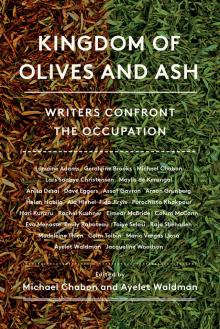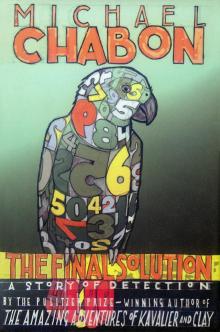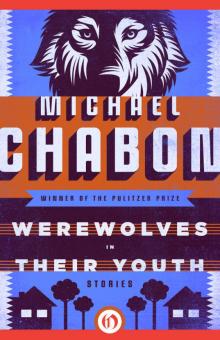- Home
- Michael Chabon
Kingdom of Olives and Ash: Writers Confront the Occupation Page 24
Kingdom of Olives and Ash: Writers Confront the Occupation Read online
Page 24
“What did you shout about?”
“Usually about a girl I liked.”
Rita is the name Mahmoud Darwish gave the girl he liked. Zaher shares this casually. “Everyone knows that Darwish’s lover was Israeli.” “The national poet of Palestine had an Israeli lover?” I am incredulous. “Who was this Rita?”
Zaher doesn’t know.
But, as of two years ago, many do.
In August 2014 the Arab-Israeli filmmaker Ibtisam Mara’ana released the documentary Write Down, I Am an Arab, named for the refrain of Darwish’s famous poem “Identity Card.” At one point in the film a recording of the enigmatic poet’s voice plays: “Rita is a name that I chose. Rita in all my poems is a Jewish woman. Am I revealing a secret?”
In part. As Zaher suggests, long before the release of the documentary, Darwish fans knew that the Rita in poems like “Rita’s Long Winter” and “Rita and the Rifle” was his lover. Though the poet claimed that he’d created the alias for artistic reasons, he never hid the fact that Rita was Israeli, destined to join the same army that had destroyed and occupied his homeland. In his 1973 memoir Journal of an Ordinary Grief, Darwish writes:
Between sand and water, she said, “I love you.” And between desire and torture, I said, “I love you.” And when the officer asked what she was doing here, she answered, “Who are you?” And he said, “And who are you?” She said, “I’m his sweetheart, you bastard, and I’ve come with him all the way to the gate of this prison to say goodbye. What do you want with him?” He said, “You should know that I’m an officer.” “I too will be an officer next year,” she said. She brought out her military induction papers. The officer then smiled, and pulled me away to prison.
Rita’s true identity would remain a secret for some forty years; in 2014, six years after Darwish’s death, she “outed” herself in Mara’ana’s film. An Israeli of Polish origin, Tamar Ben Ami was working as a dancer in Haifa when she and Darwish met.
A dyed-in-the-wool romantic, I am instantly intrigued. It can be difficult not to compare Israel with its historical precedents—for example, the apartheid states of pre-1964 America and pre-1994 South Africa—and I find myself searching for a parallel: a renowned brown intellectual with a white partner. There is, of course, Frederick Douglass’s second wife (Helen Pitts) and Amiri Baraka’s first (Hettie Cohen), Richard Wright’s two white wives (Dhimah Meidman, Ellen Poplar) and Alice Walker’s husband (Mel Leventhal). Perhaps because my own family is composed of so many so-called interracial couples, I have always been moved by these figures: activists whose revolutionary politics do not dictate or delimit their emotional attachments. Leaving aside the personalities involved, one might view such relationships as a hopeful act, proof that one can denounce the grotesque political systems that seek to divide human beings while, in the most personal way, affirming the shared humanity of the same. That Mahmoud Darwish, who so tirelessly condemned the Israeli state’s dehumanization and deterritorialization of the Palestinian people, could nevertheless see the humanity of his Israeli lover: this says something. At least it says something to me.
By the time I discover Rita I’ve spent a week in Israel and occupied Palestine, observing the effects of systematic disenfranchisement and recognizing them as the classic aims of the apartheid state. In the more isolated pockets of Palestine (isolated meaning not rural, or not only, but stranded, ringed with settlements) the prospect of an interfaith relationship is unthinkable precisely because human contact has been so violently curtailed. There, in places like Hebron and Nabi Saleh, where Israeli soldiers and settlers relentlessly harass Palestinian villagers, one can scarcely imagine circumstances under which a civil, let alone sentimental, encounter might arise. The strategic dehumanization of the Palestinian population has replaced the possibility of love with the pervasiveness of hate—not only for fully cognizant adults but, more devastatingly, for their children.
When, for example, on our first day in East Jerusalem, an armored bus of Jewish children pulled up to the barred front gates of their settler family’s building, what struck me most were not the guns strapped to the chests of the policemen who escorted the children to their door, but rather the looks on those children’s faces. These were Israeli children taught to fear—and, as a logical extension, to hate—Palestinians, much as white children were once taught to fear African American bodies, white South African children, black ones. It is the go-to strategy of any apartheid state: the indoctrination of children and the absence of empathy it ensures. A white child taught to fear a brown one will not speak to that child, play with that child, learn anything of or see the humanity in that child—and will most certainly never love him. In this sense a bedtime story is as potent a weapon as state-sanctioned violence or court-upheld law: history’s most brutal segregationists have all begun their work at home.
Learning of Darwish’s Jewish lover, I am suddenly heartened by a thought: that the unraveling of Israel’s segregationist fabric might begin at home as well. To imagine an interfaith romance in Hebron, where mere encounter carries the promise of violence, is impossible. But on the sandy beaches of Tel Aviv? In the leftist, activist, secular (vegan) circles of bohemian Jerusalem? In this glittering city of Ramallah, where high heels seem more common than hijabs? Darwish’s story is cinematically romantic—handwritten love letters from a Palestinian poet to an Israeli dancer!—but I can’t believe the West Bank version of West Side Story so rare. In a week I’ve met so many open-minded activists: Muslim and Jewish, highly educated, antioccupation, precisely the kind of people who wouldn’t see faith as a barrier to love. Just as interracial marriage is unremarkable among the educated elites of the coastal US, I wonder now if relationships between liberal Palestinians and Israelis are common.
And so I ask.
“Do Jewish and Palestinian citizens of Israel ever date?” I ask Zaher as we head to Orjuwan, stop number one on my one-night tour of West Bank bars. Leaving the museum, I am suddenly less interested in Ramallah nightlife than in Haifa romance—although, by the end of the evening, the proximity of the topics will come clear. Nightlife around the world is the domain both of the wealthy, that is, the leisure class, and of the liberal. To explore the swanky clubs of Ramallah is, on the one hand, to explore occupied Palestine’s moneyed class, a demographic as commonly ridiculed as it is globally ubiquitous. Women teetering on their designer heels, men leaving their luxury cars with valets, purple-tinted lights and pink-tinted cocktails: elite nightlife looks and smells the same worldwide. The problem with elite nightlife in beleaguered places is precisely this: that it flaunts the standard excesses of the few in the face of the standard sufferings of the many. All that I’ve heard and read of Ramallah points to this familiar problematic: the massive chasm between its upper-class residents and occupied Palestine’s poor. Certainly, leaving the museum at sunset, I am struck by the palpable affluence of the place; with its luxury condos and manicured palms, Masyoun Heights feels less like the West Bank than West Hollywood. In part, my interest in Ramallah nightlife stems from an abiding curiosity about the global politics of privilege. To what extent does a society’s elite seek to remedy or to maintain that society’s inequities? Is there not something intrinsically off about sipping poolside cocktails at Snowbar while knowing that, beyond the pine trees, children are being evicted from their homes in East Jerusalem?
Any investigation into what we might call a club scene in the developing world must attend to these questions of social inequality. Equally interesting, though, are questions of social transgression. At the other end of the nightlife spectrum, far from the neon lights and saccharine drinks, lies the social space known as the underground. If nightclubs offer society’s elite a stage on which to display their privileges, they also offer society’s rebels a playground for exercising their freedoms. This version of nightlife favors rule-breaking behavior over consumerist performance; however famous, underground clubs exist to house, and to hide, transgression. Whatever practices a societ
y considers taboo—the consumption of drugs and alcohol, homosexuality, female sexuality—take root in these darkened spaces. I want to visit Ramallah’s clubs because I want to meet Ramallah’s rule breakers: youth with a measure of privilege, yes, but also with a spirit of nonconformity.
I am specifically interested in meeting women, ones whom the Western media rarely portrays: educated twenty- and thirtysomethings living “modern” lives in Palestine. My father spent over thirty years in Saudi Arabia; in my experience, one of the biggest misconceptions about the region is that no educated, empowered woman would willingly choose to live there. Knowing this to be false, I am keen to speak with women who have the means to travel but who have nevertheless chosen to live in Palestine or Israel and who do so on their own terms. Hence, Ramallah. In the conservative Muslim culture that distinguishes most of Palestine, a woman swilling Taybeh and smoking shisha is making a statement. On my night out I meet, as I’ve hoped, thrillingly brazen women charting a course between honoring family traditions and defining individual boundaries.
“My mother knows that I go clubbing,” says one, Layla, lighting a cigarette. In her early thirties, single, employed by a Ramallah-based NGO, Layla typifies the six women who have joined me for the night. “She doesn’t like it, but she accepts it. I studied well. I work hard. I’m a good daughter. One day I’ll get married. But that day is not tomorrow.” These are women after my own heart. They like to flirt, to drink, to smoke, they tell me, laughing. They like sex. In this they are no different from their single male friends. Some lie to their parents and brothers about frequenting Ramallah’s clubs, uninterested in being shamed for their unapologetic pursuit of pleasure. Others demand that their families accept their lifestyle as an expression of a twenty-first-century femininity as Muslim as it is modern. For both groups—those who confide in their families and those who cannot—Ramallah’s club scene offers a safe space for all behaviors.
All except for one.
“Have you ever dated a Jewish man?” I ask this gathering of free-spirited women. Silence. The energy at the table shifts. A ripple of nervous chuckles. No, never, five of them say, raising their eyebrows and stirring their drinks. “Would you date a Jewish man?” The answer is the same. No, never. I ask if they’ve heard of Darwish’s Israeli lover Rita.
“Of course. But he was a man,” one says.
“And very young at the time,” adds another.
No one seems keen to discuss the topic further. “It isn’t done” would appear to be the general sentiment. At this table full of rule-breaking women, one rule stands: Arabs don’t date Jews. Only later does Fatima, who has kept quietest, explain why. A British-born Palestinian, Fatima has recently moved to Ramallah from London. When the others go to the bar for drinks, she shyly comes to sit next to me. Lowering her voice, she confides that she had a Jewish Israeli boyfriend in graduate school. She doesn’t want the others to know, she says, because she’s found that Palestinians judge her harshly, condemning her for having “slept with the enemy”—an accusation she has levied at herself. In the course of her yearlong relationship she never stopped wondering whether her boyfriend saw her as his equal, whether his attraction to her was a form of exoticization, a sexualized curiosity about the Other. Fatima’s anxieties recall those I’ve heard from brown women in other contexts: African American women dating white American men, West African and Indian women dating British. In my observation, where the man in a couple belongs to a socioeconomically dominant culture and the woman to a historically disenfranchised one, questions of power arise very quickly. Is the white man acting out a fetish of the brown female body, a perverse conflation of social privilege and sexual dominance? Does the brown woman betray her antioppression politics by “submitting” her body to a member of the oppressing class? Added to the power imbalance inherent in any man-woman relationship in a patriarchal setting, ethnic inequality will most always destabilize a romance in a racist one.
Of course, the distorting effect of power disparity works on the minds of men, too. Days after meeting Fatima I sit down with Esther, a Jewish graduate student, in Jerusalem. For two years she has been with Diaa, a Palestinian citizen of Israel educated in the United States. Much like Fatima, Esther speaks of her relationship in nervous whispers, reluctant at first to talk to me, wary of being overheard. While Esther’s parents adore Diaa (“my father is always texting him in Arabic”), her grandmother refuses to meet him, devastated that Esther has chosen such a fraught path. Diaa’s parents, meanwhile, have no idea that Esther exists. They live in a small Palestinian village, she says, where everyone knows everyone else. Though Diaa suspects that his parents are open-minded enough to accept his relationship, he fears that the rest of their village is not. Not wanting his parents to be ostracized by their community, he has spared them the burden of knowledge. When Esther and I meet, she and Diaa have recently returned from their first trip to the States. With palpable sadness she recounts their return to Tel Aviv.
“We were going through the first security check in Turkey and he said to me, ‘If they bother me, just keep going. Don’t wait for me.’ And when we landed in Israel, there they were. Right at the door as you walk off the plane. I don’t know if they somehow knew he was on the flight. They stopped him instantly. Before anything, before he’d even taken a breath of the air of this land. I was freaked out. I know they have their little prisons at the airport; I didn’t want to leave him. So I walked a few steps, then I kind of waited, and they noticed. They called me over and asked for my information, too.
“Nothing big happened. But when we walked away, he was really upset with me. He didn’t want me to put myself in the position of protecting him. Something about the incident made him feel so weak, so uncomfortable. It’s such a crazy thing. I do get this protective feeling. I do feel my social power in comparison to his, in these moments. And I do feel: ‘Maybe it’s good for them to know that he’s associated with a good Jewish girl. Maybe then they’ll leave him alone.’”
Both Fatima’s and Esther’s accounts would seem to underline a primary complication in Palestinian-Israeli relationships: a racialized imbalance of power. Without wishing to generalize, I would imagine that the issue is exacerbated when the man is Arab. The versions of Jewish and Muslim culture that appear to have achieved social dominance in Israel and Palestine are markedly conservative ones, especially where gender roles are concerned. For an Arab man, whose culture privileges a patriarchal model of manhood, the idea of needing protection from any woman—much less a Jewish woman—must be anathema, I propose to Esther. She agrees. And yet the countless forms of intimidation and violence inherent to the occupation make any other dynamic impossible. How does one not try to protect a loved one from persecution? How to move through the world as a unit when one’s freedom of movement is so grotesquely different from one’s partner’s? The same questions arise in relationships between Arabs with differing citizenships, Esther explains. Diaa’s previous relationship, with a Palestinian woman in Ramallah, ended because he holds an Israeli passport and she does not. “He couldn’t give up his citizenship, the right to see his family.” I ask if any of her friends—all of whom know of and support her relationship with Diaa—are in interfaith relationships themselves.
“Not anymore. For most people it’s just too hard.”
The silence with which my question was greeted in Ramallah begins to make more sense. It is not, as I’ve feared, that my Palestinian and Jewish peers have drunk the Kool-Aid, accepting the purported Otherness of their neighbors. Rather it seems that, whatever natural instinct toward intermixing may exist, the legal and logistical barriers are astoundingly, discouragingly high. Indeed, despite the parallels that can be drawn between interfaith dating in Israel and interracial relationships elsewhere, something in my whispered conversations points to a unique dynamic. That something is the threat of physical danger.
“I would never date another Israeli,” Fatima says. “It was hard enough in London. But here I�
�d be endangering myself and, worse, my boyfriend.” Fatima’s current partner is a US-educated Palestinian activist (the only man, she notes, who did not stop dating her on learning of her Jewish ex). I have been told that both Israeli and Palestinian authorities use blackmail as a form of political control over Palestinians—taking photographs of citizens in compromising positions, then threatening to publicize those images if the citizen doesn’t collaborate—but I am shocked to learn that interfaith dating constitutes a compromising behavior in 2016. My Ramallah hosts are much more willing to speak openly about this: the very real danger faced by Arabs and Jews who have fallen in love. Their stories are horrifying: of Palestinians photographed with Jewish partners, then threatened: “If you don’t inform, we will send these photographs to your family.”
I have been naive, I see, to conceive of Palestinian-Israeli relationships in terms of liberal politics alone. Even for the twenty- and thirtysomethings whom I envisioned as champions of a defiantly humanist position, the risk of harming one’s family seems an impossibly high price to pay. It is one thing not to have met your girlfriend’s woefully bigoted grandmother. It is another thing entirely to face physical and political intimidation on account of whom you love. By way of analogy, interracial dating in the United States simply cannot compare, at least not in a twenty-first-century context. The barbaric antimiscegenation practices of the twentieth century, or the present-day criminalization of homosexuality in the developing world, comes much closer. If the story of Darwish and Ben Ami speaks to a beautiful possibility—the transcendence of apartheid politics at the level of human interaction—the fear in Esther’s and Fatima’s voices betrays an uglier reality: the trauma experienced by those Palestinians and Israelis who dare to love.

 McSweeney's Mammoth Treasury of Thrilling Tales
McSweeney's Mammoth Treasury of Thrilling Tales The Amazing Adventures of Kavalier & Clay
The Amazing Adventures of Kavalier & Clay The Yiddish Policemen's Union
The Yiddish Policemen's Union Wonder Boys
Wonder Boys Manhood for Amateurs
Manhood for Amateurs Kingdom of Olives and Ash: Writers Confront the Occupation
Kingdom of Olives and Ash: Writers Confront the Occupation Gentlemen of the Road: A Tale of Adventure
Gentlemen of the Road: A Tale of Adventure A Model World and Other Stories
A Model World and Other Stories Pops: Fatherhood in Pieces
Pops: Fatherhood in Pieces McSweeney's Enchanted Chamber of Astonishing Stories
McSweeney's Enchanted Chamber of Astonishing Stories Summerland
Summerland Telegraph Avenue
Telegraph Avenue The Final Solution
The Final Solution The Mysteries of Pittsburgh
The Mysteries of Pittsburgh Werewolves in Their Youth
Werewolves in Their Youth Bookends
Bookends Fight of the Century
Fight of the Century Maps and Legends
Maps and Legends The Amazing Adventures of Kavalier & Clay (with bonus content)
The Amazing Adventures of Kavalier & Clay (with bonus content) Kingdom of Olives and Ash
Kingdom of Olives and Ash Pops
Pops Gentlemen of the Road
Gentlemen of the Road The Final Solution: A Story of Detection
The Final Solution: A Story of Detection Telegraph Avenue: A Novel
Telegraph Avenue: A Novel